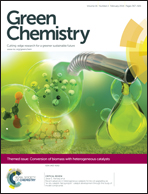Ab initio and classical simulations of the temperature dependence of zeolite pore sizes†
Abstract
Ab initio and classical simulations were used to study the equilibrium and fluctuating ring diameters for all-silica zeolites SOD, FER, and MFI over the temperature range 300–900 K. Such simulations are important for understanding and predicting zeolite/guest fit, especially for relatively bulky guest species, e.g., those derived from biomass. We simulated equilibrium zeolite structures, IR spectra, thermal expansion coefficients, and ring breathing vibrations to investigate the competition between negative thermal expansion and enhanced vibrational amplitudes with increasing temperature. We find that although negative thermal expansion tends to shrink equilibrium ring sizes with increasing temperature, this trend is nullified by considering ring breathing vibrations, giving effective pore sizes that are roughly constant with temperature, and larger than those extracted from X-ray data. Several force fields were tested and a modified BKS force field was found to give the best agreement with the simulated properties listed above, especially for MFI. Our results are consistent with previous work suggesting that effective zeolite ring sizes are underestimated by using oxygen ionic radii for estimating atomic excluded volume.

- This article is part of the themed collection: Conversion of biomass with heterogeneous catalysts

 Please wait while we load your content...
Please wait while we load your content...